Johnny Blaze returns to rid the world of the Devil in Ghost Rider: Spirit of Vengeance. This time around, famed Crank directors Mark Neveldine and Brian Taylor helmed the stereo follow-up to the 2007 film which also stars Nicolas Cage as Blaze and his fiery alter-ego Ghost Rider. We talk to visual effects supervisor Eric Durst, visual effects producer Jenny Fulle and lead vendor Iloura.
Although in both films Ghost Rider is seen sporting a flaming skull, Spirit of Vengeance called on the titular character to be much more dirty and gritty. “In the first film there was a clean-ness about it,” says visual effects supervisor Eric Durst. “But here he has a dark face that’s been burnt. Anything around him too becomes like that, such as his bike.” Durst took that idea to a number of effects facilities to provide tests as part of the bidding process. “Iloura did a test in record time,” he says, “and they really nailed it and got the feeling of Ghost Rider – not just taking it literally for the charred skull but they also had the dark feeling of it.”
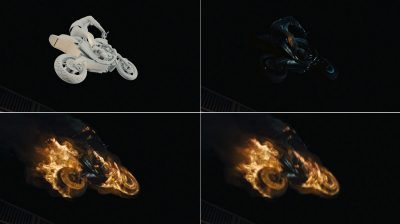
Ultimately, visual effects producer Jenny Fulle, through her Creative-Cartel production company, co-ordinated the efforts of Iloura and other vendors on 850 shots, plus the work of two stereo conversion houses – Gener8 and Legend3D. Fulle says the conversion was one of the biggest challenges conceptually. “We had to work out how to do the conversion on a 3D flaming head because of its volumetric nature,” she says. “So we came up with a hybrid pipeline with the conversion and VFX vendors. It was a 3D pipeline where we shared shots and we were able to have the VFX vendor do their matchmove and roto work, send it to the conversion vendor to do left eye/right eye and send it back with the cameras to VFX to render natively in stereo.”
The effects shots were reviewed mostly via cineSync sessions, relying on 5thKind to manage assets and a tailored FileMaker Pro database to manage the shots from companies in LA to Melbourne. Fulle says, “it’s kind of business as usual for us dealing with companies around the world so that was very manageable. Shooting in up-and-coming locations in Romania and Turkey can be a little challenging because they take a lot more planning – you can’t just get a crane sent out – but you have to improvise and that’s what we’re able to do.”
‘We just went out and shot’
Owing to a relatively short pre-pro schedule and the hands-on approach of the directors, Durst says Spirit of Vengeance did not follow a typical planning and previs effort. “Because of the way Mark and Brian shoot – at their heart they are camera operators – the production was more run and gun, which suited the style of the film anyway. They’re more like director-cameramen. They use the camera as an actor in the film. So instead of telling the operator to get in closer and do one thing or another, they would grab the camera and actually do it.”
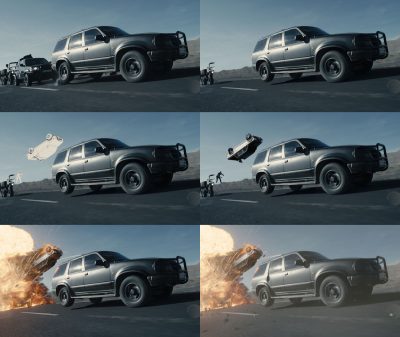
“In one case,” adds Durst, “we were up in Transylvania in these mountains on this very narrow road and Mark likes to shoot with his camera on roller blades. So he’s going frontwards and backwards with the camera looking at a motorbike going at least 45 miles an hour – no protection at all – just doing it. He got fabulous imagery from it. It gives a degree of intimacy that you often don’t get with the director talking about what they want, as opposed to doing it. They pretty much did that in the Crank movies, as did the DoP Brandon Trost.”
On set, this on-the-fly approach required quick set-ups with the RED One MXs and fast camera lens and data acquisition. “For survey data,” says Durst, “we used the Civetta – a panoramic camera with full dynamic range so you can shoot effectively 26 stops. It will do the complete 360 in 45 seconds. That gave us HDRI data and textures very quickly. You can also do a low position and a high position and use it to triangulate measurements to get lidar-type results. We tried to also get clean plates and extra photography reference where we could.”
Flame-on
The notable visual effect in Spirit of Vengeance is, of course, Ghost Rider’s flaming head. To film plates for these shots, Nicolas Cage wore an LED helmet on set. “It was a hood that went on his head and there were LED lights that flickered in yellow and orange,” explains Durst. “That gave a sense of interactive light on the garments and faces. Then we had tracking points on the helmet itself and Nic also wore this dark make-up to get him into character.”
Watch a further scene from the film.Iloura was then tasked with creating ‘art-directable’ flames that worked in both nighttime and daylit settings (something that had not been seen in the original film). “The flames are like the tail of a dog,” says Durst. “They’re expressive elements and express a lot of what Ghost Rider is feeling. In some cases where he gets all pissed off, they’re faster and shoot off more. They really did a great job with it.”
Iloura visual effects supervisor Glenn Melenhorst oversaw the work of 60 to 70 artists at the Melbourne facility over six months of post-production, which began with matchmoving and roto (outsourced mostly to Yannix). “We then removed Nic’s head,” says Melenhorst, “and often had to hand-paint or generate empty plates. We’d restore the back of the collar too which sometimes was a simple roto shape because there was so much fire and smoke and sometimes we tracked a 3D digital collar which was deforming and twisting.”
A skull created as a ZBrush sculpt, brought into Maya and rendered through 3ds Max in V-Ray, was then blocked into the flaming head shots. “This was a lot more demonic and angular than a normal skull,” notes Melenhorst. “We looked at charred helmets and burnt skulls for reference.”
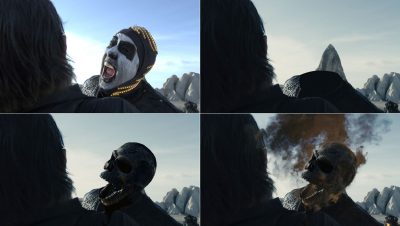
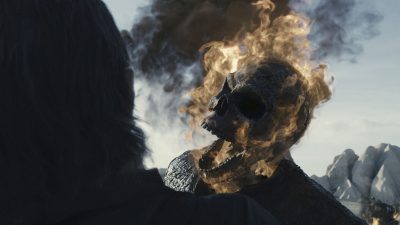
Iloura then used a range of tools to accomplish the flames. “FumeFX was our preferred package,” says senior effects animator Paul Buckley. “We did look into Maya Fluids and Phoenix which was just coming out at the time, but FumeFX seemed quicker than the others. For rendering we had to consider things like GI flickering so we had a hybrid pipeline of mainly V-Ray but also Final Render. We used Nuke for compositing.”
FumeFX provided the base-level simulation that was then combined with Krakatoa particles interacting with the Fume sims. “We’d go through iterations and find sims that hit the mark and we could sometimes squirrel those away for something else,” says Melenhorst. “We also went through a process of working out whether the flame existed within the grid the sim is in traveling with the object, or whether it should be static with the object, having its forward momentum mitigated and then having wind and other forces pushing it so we could art direct it differently.”
Smoke, too, was generated in the Fume sim and mixed and matched where necessary. In addition, Iloura added interactive lighting in addition to the in-plate LED effects, and hand-tracked bubbly patches to Ghost Rider’s jacket to show it fizzing in the heat. A digi-double version of the character was also created from a Cage cyberscan and photo reference – used mainly for transitions when the live-action actor needed to perform crazy stunts. “For one shot,” recalls Melenhorst, “we had Nic Cage sitting on the bonnet of a car in a studio jumping into the air. We had to put a digital environment around that and put wheels on the car, so it was traveling. Then we did a full digital translation of Cage as he passed over camera and onto a bike.”
Hell on wheels (and treads)
Ghost Rider’s signature motorcycle was also occasionally a digital creation based on a real prop which was cyberscanned. In live-action bike shots, Iloura had to paint out various rigs and then add fire and smoke in the same manner as the flaming skull shots. For the character’s weapon of choice – his chain – artists built a 3D rig that was hand animated to perform whip-like moves. Says Melenhorst: “We actually bought bits of chain and when you pick them up they don’t really do much. We wanted it to feel heavy and metal instead and be deadly, so the challenge was getting the right fluidity out of it.”
Watch behind the scenes of the Hell Crane shoot, and a final shot.Like his bike, any machine Ghost Rider operates becomes a ‘Ghost Rider’ device. One such device was a massive strip miner/digger on treads – the Hell Crane – which quickly becomes a deadly weapon against Ghost Rider’s foes in a quarry. For the crane itself, production shot with a real machine that was photographed extensively for VFX work. “We used some point cloud software to reconcile multiple photos of the digger,” says Melenhorst. “We made a polygon point cloud data set which gave us enough information to then build the thing by hand – every strut and nut and bolt. We also built the quarry around it and added digi-double mercenaries. We actually mo-capped them with a Kinect into MotionBuilder and then keyframe animated them.”
The digital crane launches into crushing moves, with Fume FX fire elements added along with Thinking Particles used to deal with dirt and mashed-up and exploding crates. “We also began at first by animating the crane the way it would move in reality,” says Buckley, “but the directors wanted to make it move much faster to do impossible moves. In the end it was really quite fun – and went to a supernatural place.”
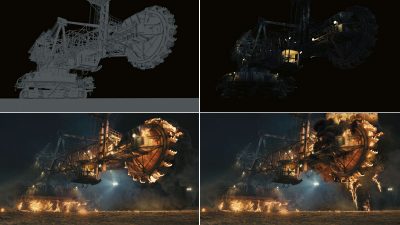
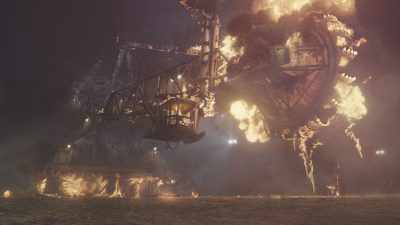
Iloura was also responsible for several disintegration and ash effects, explosions and a number of somewhat unusual uses of Ghost Rider’s powers. In one scene he dispatches victims with projectile vomit-like flames – relying on Fume, RealFlow and Max – and in another he urinates a liquid-y flame (a popular shot from the film’s first trailer). For other shots, the visual effects studio was challenged to come up with difficult solves. “There was one shot of a convoy of five cars traveling along the road,” says Melenhorst, “and after they filmed that the directors decided that the middle one would explode. There was no clean plate, we had to invent a pyro element, fix the plate and combine everything – it was weeks and weeks of work for people. But it’s a fun shot and the directors were great filmmakers in terms of their pragmatism – if they had a great idea they got really excited by it.”
For Eric Durst, such shots represented the willingness of the directors to have fun with the material and to embrace the prospect of a crazy or unusual shot. Nic Cage, too, says Durst, was willing to take on the character in a way that directed the performance of the digital work down the track. “I remember on the first day Nic had these contact lenses that were all dark and he had a wild sort of make-up that had a primal/animal feeling. The first time he came out, he had this hood on, and he was looking around the set and he asked me to come over and he whispered something and I didn’t understand him and he made me come even closer and he said, ‘Tighter’ in this distinctive voice and he just of course wanted it more tight – it was just really scary and powerful.”
Click here to watch Iloura’s VFX breakdown for Spirit of Vengeance.
All images and clips copyright © 2012 Columbia Pictures.
